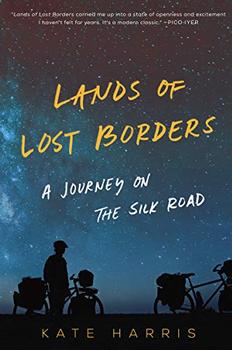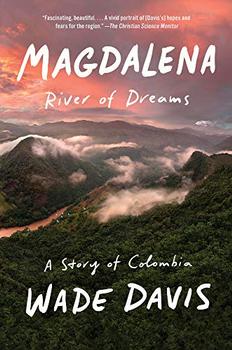Summary | Excerpt | Reviews | Beyond the book | Read-Alikes | Genres & Themes | Author Bio

A Journey on the Silk Road
by Kate HarrisPowered by imagination, grit, a bicycle, and the companionship of her best friend Mel, Kate Harris ventured twice—once in 2006 and again in 2011—to travel parts of the Silk Road (a network of ancient routes linking China, Central Asia, and Europe). More than a travelogue, this substantial narrative detours into myriad topics that spark the author's intellectual curiosity: ecosystems, borders, history, the notion of exploration itself. An Oxford-educated Canadian with a love for ideas, poetry, and adventure, Kate writes with lyrical intensity—so much so that I've underlined a quotable passage from just about every page.
In high school, Kate dreamed of becoming an astronaut. "There seemed few outlets left for the restlessness that ached inside me, this mad longing for a world without maps," she explains. She was inspired by early female adventurers Fanny Bullock Workman (who cycled across India in 1897 and summited several Himalayan peaks) and Alexandra David-Néel (a bold scholar of Buddhism who traveled the Himalayas). Kate entered a PhD program at MIT, but soon realized her passion was to explore outside of the laboratory. She participated in various field studies that took her to Utah, Mongolia, and Antarctica, further igniting her passion for travel. During her journey, Kate kept a journal filled with wide-ranging thoughts and ideas, including ruminations on language: "The Latin root of the word explorer is ex-plorare, with ex meaning 'go out' and plorare meaning 'to utter a cry'. Venturing into the unknown, in other words, is only half the job. The other half, and maybe the most crucial half for exploration to matter beyond the narrow margins of the self, is coming home to share the tale."
A map in the frontispiece of the book serves as a very rough guide to Kate and Mel's 10,000 km journey, though I yearned for more precise waypoints that would coincide with particular episodes of the trip. I highly recommend readers visit the author's website to view a 10-minute video created to promote their 2011 Cycling Silk expedition. The video captures moments described in the book: rain pounding onto their tent, snowstorms, mountain ascents, desert heat, laughter, and voices.
The author writes not only about the wonders of the road, but the low points and detours as well, including hunger, bone-chilling cold, extreme altitude, illness, and apprehension about strangers. More often than not, however, her encounters with others are demonstrative of the human elements that bind us all together despite gaps in language and culture. Kate meets young girls fascinated by bicycle gear and by Mel's flaming red hair, and Tibetan pilgrims traveling the same highway, but on their knees and foreheads, bowing each step of the way. In Samarkand, Kate sees small boys climbing mulberry trees to shake fruit from branches while elders hold a blanket to catch it, following an age-old tradition. The author also notes that since the 4th century BCE, mulberry cultivation has been essential, since silkworms eat mulberry leaves. Without silkworms there would be no Silk Road, at least not by its present name.
After their bikes are temporarily lost in the Chinese train system, Kate, Mel, and a Swiss cyclist splurge on a taxi ride to the Mogao Caves, also known as the Thousand Buddha Grottoes (near Dunhuang, China). The Grottoes' carvings and frescoes date to the 4th century CE. Despite having been looted and damaged by earthquakes over the centuries, much of the sacred art survived, even enduring Mao's violent Cultural Revolution during which many icons and artifacts were destroyed. When the bikes are located, Kate and Mel advance closer to the Tibetan Autonomous Region (TAR) and are increasingly conscious of being in a place known for both its immense historical importance to Buddhism and its political volatility. Since the 1950s, China's central government has suppressed the sacred Tibetan Buddhist culture, language, and beliefs, rejecting Tibet's claims of historic independence and sovereignty. Kate feels a sense of guilt and despair while reflecting on the region's plight: "I saw a chilling, sterilized land in which no horizon is unmarred by authority, no movement goes unmonitored, and every hint of peaceful protest is crushed beneath the heel of the state. And there I was, joyriding through this oppressive landscape, a tourist in a regime Tibetans literally set themselves on fire to protest and escape."
During this final stage of the trip, in the Himalayan region, Kate experiences "dark nights of the soul," questioning not only the condition of humanity and the degradation of nature, but her own role in the larger scheme of things. She laments an earlier ambition to colonize Mars, stating, "We didn't deserve a new world; we'd just wreck it all over again."
Kate Harris makes a strong argument for human understanding that transcends the lines on a map. Her journey epitomizes how political borders are arbitrary, often separating families, dividing religious, cultural, and linguistic groups, and interfering with ecological habitats. There is a freedom of spirit that exists beyond these borders, a freedom of the imagination, a freedom that readers might discover when falling into the world of an enthralling book. Lands of Lost Borders is notable for its lyrical prose, intellectual honesty, and courage to tackle complex questions without clear answers. It will appeal to fans of Cheryl Strayed, Rebecca Solnit, and Pico Iyer, and to anyone who has contemplated setting a new personal goal for travel, art, music, science, work or athleticism.
![]() This review was originally published in The BookBrowse Review in August 2018, and has been updated for the
July 2019 edition.
Click here to go to this issue.
This review was originally published in The BookBrowse Review in August 2018, and has been updated for the
July 2019 edition.
Click here to go to this issue.

If you liked Lands of Lost Borders, try these:

by Carolyn Phillips
Published 2021
Part memoir of life in Taiwan, part love story―a beautifully told account of China's brilliant cuisines…with recipes.

by Wade Davis
Published 2021
A captivating new book from Wade Davis--award-winning, best-selling author and National Geographic Explorer-in-Residence for more than a decade--that brings vividly to life the story of the great Río Magdalena, illuminating Colombia's complex past, present, and future.
Your guide toexceptional books
BookBrowse seeks out and recommends the best in contemporary fiction and nonfiction—books that not only engage and entertain but also deepen our understanding of ourselves and the world around us.